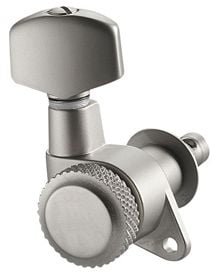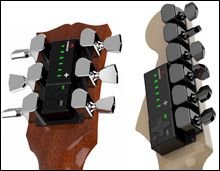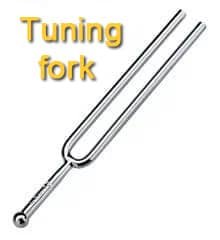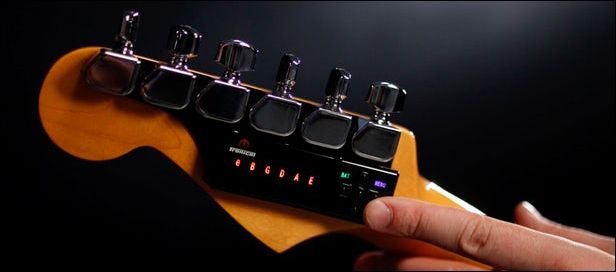KNOW the BEST Tuning Pegs for Electric Guitar Headstock: Types, Characteristics. How to Change STRINGS to the GUITAR.
Something that reveals the quality and category of a guitar is its tuning stability. But there are many factors that can influence the tuning stability, such as the quality and construction material of the nut and the saddles, and of course the quality of the tuning pegs.
Although a very important factor is knowing how to properly place guitar strings.
Electric Guitar Tuning Pegs: Locking Tuners

The most efficient and fastest way to string is by using locking tuners. Since it would be almost impossible to err in the process of installing a new string, as it could happen in a standard headstock.
In the case of locking tuners, we would simply have to pass the string through the hole in the peg, tighten the string by hand, tighten the lock, and tune the string.
What the blocker does is hold the string to the winch, similar to how a terminal block would hold an electrical cable.
In the placement of strings in the standard tuning machines, the process is not so simple. But if we follow the steps indicated on the How to Place the Strings on the Guitar page, we’ll have the same tuning efficiency as if we had a set of locking tuners mounted on our guitar. Although it’s always better to use locking tuners if you’re used to using the tremolo arm frequently.
Placing new tuning pegs on our electric guitar is one of the easiest things to do. But before buying a new set, we must make sure that it is the correct pegs, since there are many different types.
To begin with, there are two large groups. The 3+3 sets fit into headstocks with three pegs on each side, and headstocks with six in-line pegs.
Within these groups we can find pegs held by two pivots, with one pin and a screw in a corner or on the side, or with two pins and two screws in the corners or on the sides.

Electric Guitar Tuning Pegs: Best Brands
Among the most outstanding tuning pegs brands for their value for money, we have Gotoh, Schaller, or Grover. The price of a peg varies depending on the type of manufacture and finishes. The cheapest finish is usually standard chrome plating, as opposed to other finishes such as black or gold.
The Sperzel brand is another mythical manufacturer specializing in locking tuners, and it is possibly one of the best options we can find on the market, as far as quality is concerned. Although it would be difficult to find a set of tuners of this brand for less than $120.
Paradoxically, Fender and Gibson sets of Tuning Pegs are not too expensive, since models that exceed 90 dollars would be rare.
The Kluson brand has an infinite number of tuning pegs models with a truly unbeatable value for money. This manufacturer sells models in different finishes, with and without lock, with a price ranging between $25 and $60, and they fulfill their role as champions.
Automatic Tuning Pegs

In the Tronical brand we have the automatic tuning models, both in 3+3 format, and six in line. These tuners incorporate a small independent electric motor for each tuner, which will tune each string quickly and automatically.
The installation of this system in any standard headstock is very simple. We would only have to place the mechanism on the back, and install the tuning pegs as if it were a normal set.
Then we charge the lithium battery with autonomy for 300 tunings, we place the strings in the locking system of each peg, we cut the excess string and ready to go.
When the system is offline, the Tronicals would behave exactly like a normal set of locking tuning pegs. This will allow us to tune the guitar manually.
Bends and Automatic Tuning Pegs
There is a myth that the Tronical can cause problems when making bendings. Since many think that this mechanism would try to tune the string by stretching it. But this is absurd, since the system must be activated to tune, and it would automatically disconnect again until we decide to request its activation again.
Another mistaken thought is to believe that these pegs are for those who do not know how to tune the guitar. But this is ridiculous, since today it is customary to tune guitars with electronic tuners, and tuning by ear is almost forgotten. I personally can’t remember the last time I tuned the guitar by ear.
In addition, to tune by ear we would need at least one tuning fork that gives us the reference of the correct tone, to tune the rest of the strings with that reference. Since if we tune the guitar randomly, the pitch would be deviated from the standard pitch.

Consequently, we could not play on the real tonality of a musical theme, apart from not having a continuous reference of the exact sound of the authentic notes, with which our ears would get used to it.
So the sensible thing to do is to use an electronic tuner to keep the pitch right, ready to play in the true key of any piece of music.
Different Tunings Instantly
The Tronical pegs would not only tune the guitar in the standard way, but we also have different tunings built into its memory. We can also save our own tunings, and the system will allow us to go from one tuning to another practically instantly. This factor would be the strong point of this type of system.

If we generally use a standard tuning, this type of tuner may not be of much help to us. Since we will not use the most interesting function of this system.
Factors Affecting Guitar Tuning
I do not want to finish without commenting that changes in temperature will affect the tuning, and we must check its condition frequently, in places that, due to whatever circumstance, do not maintain a stable temperature.
Knowing the factors that can improve the tuning stability of our guitar is essential. Some typical features of the instrument, such as movable bridges, or even techniques specific to the electric guitar like bending, will continually test this stability.
